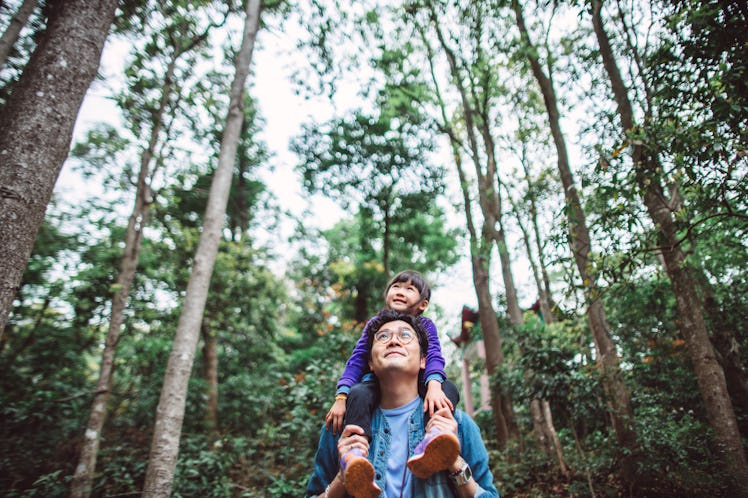The Very Real Benefits Of Shinrin Yoku, AKA Forest Bathing
No nudity required.

First things first, shinrin-yoku does not involve stripping down and diving into a pile of leaves. If that’s your thing, more power to you, but the official practice of forest bathing is about using the senses to connect to nature (while fully clothed). This intentional practice has a ton of mental and physical health benefits including the lowering of blood pressure, pulse rate, and anxiety levels compared to a normal walk around the block. And that’s just the start of what shinrin-yoku, also known as forest bathing, can do for your health. It’s also a great way to get your kids into the great outdoors and keep them busy once they’re there, in winter, spring, summer, or fall.
What Is Forest Bathing (Shinrin-Yoku)?
Shinrin-yoku is essentially a mindful walk in a natural setting. In practice, it means leaving devices behind (or turned off), and letting your senses tune back into the natural world.
“Forest bathing came out of Japan in the early 80s as an intentional time in nature using all of our senses,” says Erica Timko Olson, Ph.D., a professor in the Adult and Gerontological Health Cooperative at University of Minnesota School of Nursing who studies nature-based therapies and wellness. “Noticing is the biggest thing,” she says. “It’s about being fully present to the sounds, the smells, the feelings of touching the trees, the plants, the grasses. Using all of our senses in nature in that full, embodied experience.”
It doesn’t have to be ethereal to work — mushroom hunting, bird watching, and plant IDing all deliver psychological and physiological benefits. Technically, shinrin-yoku doesn’t even have to be in a forest to work; a walk around a green neighborhood can deliver a similar experience.
However, it’s important to note that your typical nature walk won’t cut it. You have to be more tuned in than that. To get your kids to make that deeper connection, ask them simple questions that require them to use their senses. What do they hear? What do they see? What does this rock feel like? How is the bark of the oak tree different from the bark of the sycamore tree? If you can find a plant you know is edible, like honeysuckle, what does it taste like?
The Scientific Benefits of Shinrin-Yoku
Forest bathing might sound too sublime to be scientific, but real research backs up this practice. In pre-hypertensive adults and those who already have high blood pressure, for example, it’s effective at lowering blood pressure, pulse rate, and anxiety levels, according to a review of 14 studies. It also improves mood, quality of life, metabolic function, and the heart and lungs.
You don’t need to have high blood pressure to benefit from forest bathing. One small, recent study found that men in Tokyo had higher levels of anti-cancer proteins and natural cell activity after forest bathing. “It increases natural cells that we know is really important for fighting off cancer cells that are in our bodies,” Timko Olson says.
Another small, recent study in middle-aged men with heart disease found that going on a forest walk rather than an urban walk was more effective at lowering their pulse rate, as well as raising their scores for vigor and lowering their scores for depression, fatigue, anxiety, and confusion.
During uncertain times, practicing mindfulness in nature may be especially beneficial to psychological well-being, according to a 2020 review study. It may also be able to boost the immune system.
“Just talking about it makes me take a deeper breath and relax,” Timko Olson says. “There’s more and more research coming out every day about the benefits of being in and walking in those green spaces.”
So how long do you need to do forest bathing for it to have an effect? “A study out of Europe found that 120 minutes a week is what we should shoot for,” Timko Olson says. “It’s kind of like the new 10,000 steps today, in a way, in that 120 minutes a week seems to have the greatest benefit for people to be spending time in nature.”
You can complete this two-hour chunk all at once or broken into multiple forest walks throughout the week. Because when you do it doesn’t matter. All that matters is getting outside.
This article was originally published on